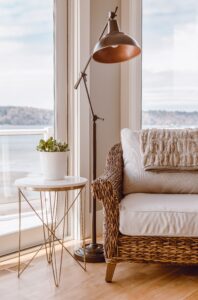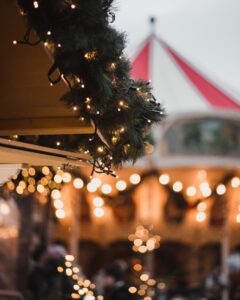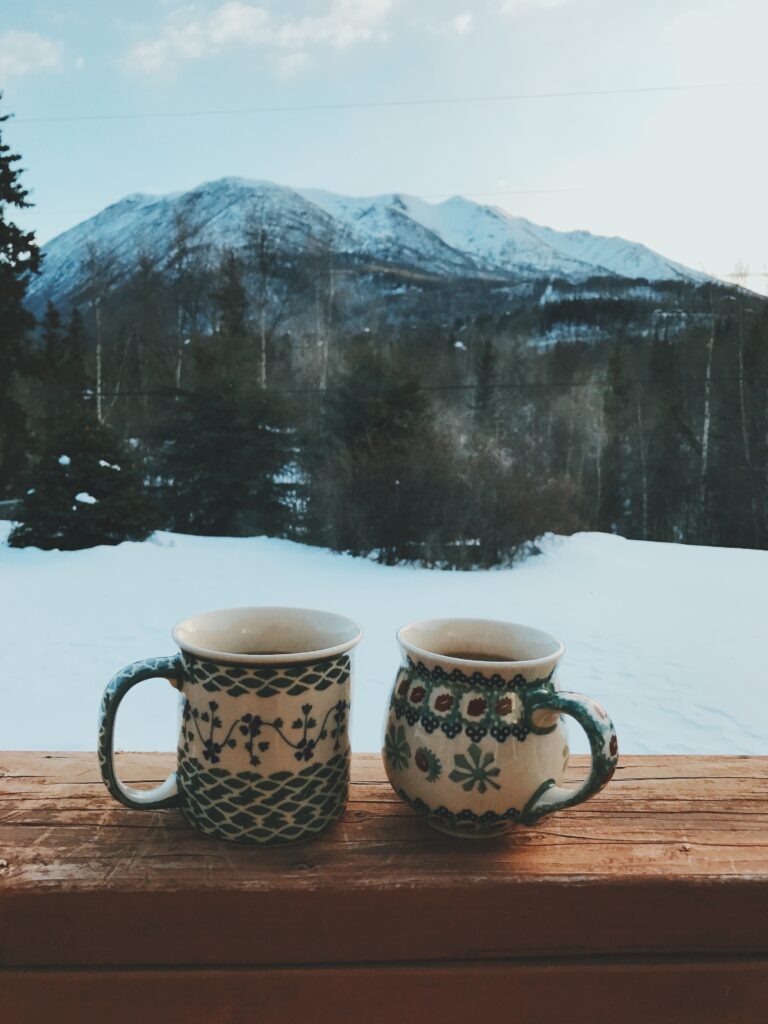The Nordic concept of hygge, pronounced “hoo-guh,” reached a new level of international fascination during this last decade, and it’s no wonder why people are so intrigued by it. The concept is rooted in creating a cozy atmosphere of togetherness and well-being. Both the Scandinavian and Nordic counties embrace hygge as a way of life.
Scandinavian and Nordic Countries are close in proximity; Nordic countries are vaguely used for Norway, Denmark, Sweden, Finland, and Iceland. Scandinavian countries include Norway, Sweden, and Denmark.
The origins of hygge originated in old Norwegian and first appeared in Danish writing around the end of the 18th Century, and the Danes have embraced it ever since.
It derives from a sixteenth-century Norwegian term, hugga, meaning “to comfort” or “to console,” which is related to the English word “hug.” Associated with relaxation, indulgence, and gratitude, hygge has long been considered a part of the Danish national character.

Photo by Tina Witherspoon on Unsplash
Winter is the most hygge time of year! Recently we traveled to three Scandinavian countries during the Christmas season, and hygge was weaved into every aspect of the culture. The cold, dark, and wet climate during long parts of the year encourage Danes and Nordens to spend time together indoors while still embracing winter weather outdoors. Nature plays a role in hygge living, hiking, gardening, natural colors, and crisp fresh air.
The Danish and Norwegian way of life offers a simplicity that allows for the daily expression of togetherness and gratitude.
How to Hygge Indoors:
- Add plants throughout the house.
- Add rugs to the living areas.
- Add a layer of texture with sheepskin rugs
- Decorate using minimal art (be selective)
- Use Neutral Colors
- Enjoy a cup of Glogg (yummy mulled wine)
- Add soft lighting
- Use lots of blankets
- Keep a stack of wood for use
- Use minimal practical furniture
- Hang dry clothes (slows things down)
- Light the fireplace
- Light candles
- Enjoy a good book
- Enjoy the simple pleasures with loved ones
How to Hygge Outdoors:
- Walking
- Splitting wood
- Stacking wood
- Decorate with simple Christmas décor
- Enjoy a cup of Glogg
- Enjoy a local café
- Visit old historical architecture
- Biking
- Hiking
- Play in the snow
- Reuse and recycle

Photo by Tiard Schulz on Unsplash
Oslo, Norway
Our first stop was Oslo, Norway’s beautiful capital. Oslo is famous for its modern design, historic architecture, and the
Oslo Opera House. Its one-of-a-kind architecture is designed so visitors can walk on its rooftop; it is a must-see! There are many beautiful attractions,
Top Best 18 Things to do.
The
public library rated one of the world’s top, dedicates an entire floor to children for play and learning activities. While roaming about, you can enjoy a gift shop, café, restaurant, cinema, and an auditorium; a great way to enjoy togetherness!
Christmas in Winterland (Jul i Vinterland), another fabulous find, is the primary Christmas market in Oslo.
Cozy wooden booths alongside Karl Johan street, vendors sell crafts, food, hot drinks, knitted hats, and sweaters. Handmade Christmas decorations have a whole new appreciation during this time of year.
The nights are long, and the days are short, but the twinkling lights from the Christmas décor brighten up the atmosphere. Kids are entertained with gingerbread workshops, an ice rink, a large Ferris wheel, and Santa’s residence.
After enjoying a wonderful night at the market in 30-degree weather, a lit fireplace is a must to keep warm. The aroma of burning wood is a real treat.
The homes have large windows, a practical way to warm the house and enjoy the daylight longer; the sun sets at 3:15 pm.
Bringing the outdoors indoors is a local way to hygge and one of the many things we appreciate.
Photo by Gijs Jakobs
Tromso, Norway
Our second stop Tromso, a city in northern Norway, is best known for its
northern lights. During the winter, the weather ranges from 25 – 30 degrees. The snow-covered mountain views are spectacular!
Cozy homes line the exterior of
mountains tops, and in the valley, the city moves with calmness.
Glaciers, rivers, mountain pastures, forests, and lakes surround it. What a wonderful combination nature has to offer.
The local bus is an excellent transportation source; walking is a large part of daily life and keeps most in good physical health. With its small-town feel, one could not help but appreciate its simplicity; nothing was done outlandishly.
Homes were decorated for Christmas with lights and wreaths, keeping the feel of nature. With its widely cold weather enjoying a warm drink at the mountain top is a local common practice; we gladly joined in. It can rarely be captured by pictures or storytelling. It is a moment in time, a pause in this busy world to stop, breathe the fresh, crisp air, and hygge.

Photo by Alexandre Van Thuan on Unsplash
Stockholm, Sweden
Our third stop is Stockholm, the largest city in Sweden, best known for the cobblestone streets and ochre-colored buildings of Gamla Stan (the old town). The Old Town dates from the 13th century, but most buildings are from the 1700s and 1800s.
The s
ubway, known for being the longest art gallery in the world, is the best way to travel to and from the city. Built on 14 islands connected by 57 bridges, it’s truly built on water. Like most cities, it moves fast but tucked away in a city park stood a small snow-covered hill, kiddos filled with laughter, sliding down with great joy, no sled needed. Without introduction, our daughter joined in, and there we found it, hygge.

Photo by Nick Karvounis on Unsplash
Copenhagen Denmark
Our fourth and last stop is Copenhagen, Denmark. Copenhagen is a unique city characterized by its canals, cycling culture, strong economy, and happy locals. It is known as being the happiest city in the world for its work-life balance.
During our stay, we had the opportunity to enjoy Copenhagen’s popular market place Torvehallerne. Urban-covered marketplace featuring stalls with local produce, gourmet foods, warm beverages & desserts. It’s a culinary genius! Offering more than 80 shops with mouth-watering Danish delicacies, local vegetables, fresh fish, Italian specialties, and unique Christmas shops.
We loved this market and its warm ambiance. Within walking distance is Julemarked Kongens Nytorv, Copenhagen’s most famous Christmas market! We were pleasantly surprised by Scandinavians’ long history of Christmas Markets dating back to the 1830s.
Summary
Through our travels, we found hygge can be used as a noun, adjective, and verb. The true expression of hygge is enjoying time with loved ones in a relaxed atmosphere. Creating a lovely, warm home is also an expression of hugge. Walking or riding a bike is part of daily life, taking care of your body with time outdoors, hugge can be expressed in many ways.
The Scandi/Nordic homes were decorated using neutral colors, perhaps drawing in the outdoor landscaping. Fireplaces were lit to warm the house, adding a smell that triggered a season of joy. The Christmas season is celebrated from November through December, and the history of Christmas Markets brings an element of tradition for families.
Fresh flowers are added to the interior of the homes, and soft lighting cuts through the cold, dark winters and add a layer of life! Days or short, the nights are very much enjoyed with warm cozy drinks and long walks.
Hygge is practiced in some way or another by most cultures but what makes the Nordens and Scandinavians unique is their simplicity. Their appreciation for nature, health, tradition, and simplicity creates the Hygge lifestyle.
Hygge books you may enjoy!
Lagom: The Swedish Art of Balanced Living
The Cozy Life: Rediscover the Joy of the Simple Things Through the Danish Concept of Hygge
The Little Book of Hygge: Danish Secrets to Happy Living
The Little Book of Lykke: Secrets of the World’s Happiest People
Photo by Mariah Krafft on Unsplash





